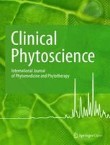Speed 2023
Submission to first editorial decision (median days): 32
Submission to acceptance (median days): 272
Usage 2023
Downloads: 483,277
Altmetric mentions: 33
Evaluation of cerebroprotective effect of Ricinus communis leaves against ischemia reperfusion injury in rats
Ricinus communis (RC) has been used for a long time as natural origin medicine in the treatment of central nervous system ailments. This present study was designed to identify the possible role of Ricinus communi...



